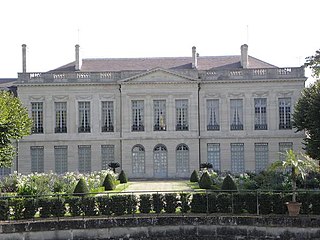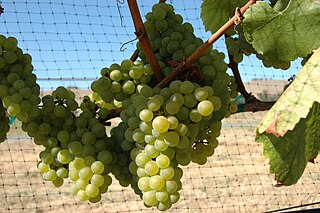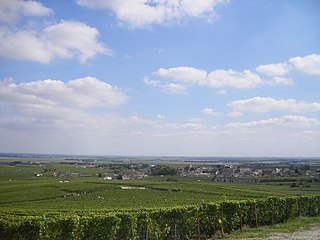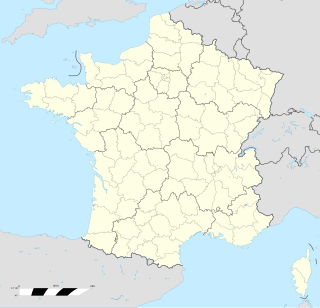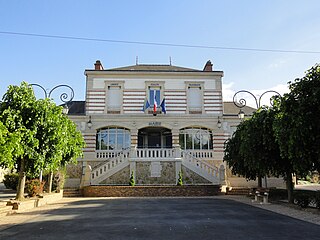
The Champagne wine region is a wine region within the historical province of Champagne in the northeast of France. The area is best known for the production of the sparkling white wine that bears the region's name. EU law and the laws of most countries reserve the term "Champagne" exclusively for wines that come from this region located about 100 miles (160 km) east of Paris. The viticultural boundaries of Champagne are legally defined and split into five wine producing districts within the historical province: Aube, Côte des Blancs, Côte de Sézanne, Montagne de Reims, and Vallée de la Marne. The towns of Reims and Épernay are the commercial centers of the area. Reims is famous for its cathedral, the venue of the coronation of the French Kings and a Unesco world heritage site.
Louis Roederer is a producer of champagne based in Reims, France. Founded in 1776, it was inherited and renamed by Louis Roederer in 1833. It remains today as one of the only still independent and family-run maisons de champagne. Over 3.5 million bottles of Louis Roederer champagne are shipped each year to more than 100 countries.

Côte Chalonnaise is a subregion of the Burgundy wine region of France. Côte Chalonnaise lies to the south of the Côte d'Or continuing the same geology southward. It is still in the main area of Burgundy wine production but it includes no Grand cru vineyards. Like the Côte d'Or, it is at the western edge of the broad valley of the river Saône, on the rising ground overlooking the town of Chalon-sur-Saône which is about six kilometers out into the plain. To the north, across the River Dheune, lies the Côte de Beaune. To the south is the Mâconnais. The grapes of the region are predominantly Pinot noir and Chardonnay with some Aligoté and Gamay also grown in vineyards spread over a stretch of 25 kilometers long and 7 kilometers wide of undulating land in which vineyards are interspersed with orchards and other forms of farming.
Krug Champagne is a Champagne house founded by Joseph Krug in 1843. It is based principally in Reims, the main city in France's Champagne region and is one of the famous Champagne houses that formed part of the Grande Marques. Today the house is majority owned by the multinational conglomerate LVMH Moët Hennessy • Louis Vuitton S.A. whose portfolio includes other well known wine brands such as Moët & Chandon, Veuve Clicquot, Château d'Yquem and Ruinart. Despite LVMH's majority ownership, the Krug family is still actively involved in all the key decisions of the house but does not manage the day-to-day operations.

Auxerrois blanc or Auxerrois Blanc de Laquenexy is a white wine grape that is important in Alsace, and is also grown in Germany and Luxembourg. It is a full sibling of Chardonnay that is often blended with the similar Pinot blanc.
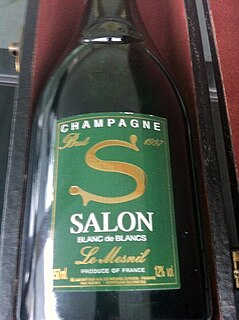
Champagne Salon is a small producer of critically acclaimed Champagne made in the blanc de blancs style. Salon, along with Delamotte, is part of the Laurent-Perrier group since 1989. It is regarded as one of the greatest Champagnes on the market.
Champagne Delamotte is a small producer of Champagne. Along with its "sister" winery Champagne Salon, Delamotte is the historical House of the Laurent-Perrier group.

Duval-Leroy is a Champagne producer based in Vertus, a village in the Côte des Blancs region of Champagne. The house, founded in 1859, produces both vintage and non-vintage cuvées as well as a line of organic wines. The house of Duval-Leroy is also known for its pioneering role in promoting a sustainable development model for its viticulture.

Saint-Aubin wine is produced in the commune of Saint-Aubin in Côte de Beaune of Burgundy. Rather than being situated on the main Côte d'Or escarpment, as most of the other Côte de Beaune wine villages, the vineyards of Saint-Aubin are mainly located in a side valley to the west of Chassagne-Montrachet. The Appellation d'origine contrôlée (AOC) Saint-Aubin may be used for white and red wine with respectively Chardonnay and Pinot noir as the main grape variety. The production consists of around 75% white wine, and 25% red wine. There are no Grand Cru vineyards within the Saint-Aubin AOC.
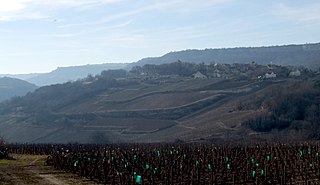
Saint-Romain wine is produced in the commune of Saint-Romain in Côte de Beaune of Burgundy. Rather than being situated on the main Côte d'Or escarpment, as most of the other Côte de Beaune wine villages, the vineyards of Saint-Romain are mainly located in a side valley to the west of Auxey-Duresses, in the direction of the communes and vineyards of the Hautes Côtes de Beaune. Most vineyards of Saint-Romain are located on slopes of various directions. The Appellation d'origine contrôlée (AOC) Saint-Romain may be used for red and white wine with respectively Pinot noir and Chardonnay as the main grape variety. A little more than half of the production consists of white wine. There are no Grand Cru and no Premier Cru vineyards within Saint-Romain.

Boll & Cie is a Champagne house based in Reims, a producer of sparkling wines from the Champagne region of France, founded in 1853. With the exception of the Brut Rose, all Champagnes from Boll & Cie are blanc de blancs. Boll & Cie specializes in Brut Champagne, including a Grand Cru from the village of Le Mesnil-sur-Oger.
The canton of Vertus-Plaine Champenoise is an administrative division of the Marne department, northeastern France. It was created at the French canton reorganisation which came into effect in March 2015. Its seat is in Blancs-Coteaux.
Agrapart & Fils is a Grower Champagne producer which makes organic wines with a focus on terroir.
Pierre Gimonnet & Fils is a Grower Champagne producer and an original member of the Club Trésors de Champagne. The domaine has 28 hectares based in the Côte des Blancs with Premier cru sites in Cuis and Mareuil-sur Aÿ, and Grand crus in Cramant, Chouilly, Oger, Vertus, and Aÿ; the fields are planted to 98% chardonnay and 2% pinot noir. The house produces 20,000 cases annually. The house is noted for old vines, with 70% over 30 years old, and even century-old vines in the Grand Cru lieux-dits of Le Fond du Bateau and Buisson. Three generations of the family have produced Champagne; today, the estate is managed by Didier and Olivier Gimonnet.
Larmandier-Bernier is a Grower Champagne producer.


